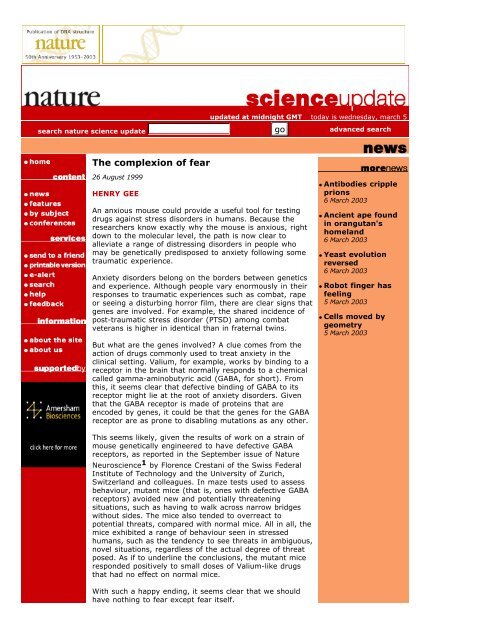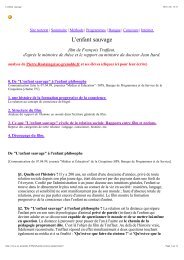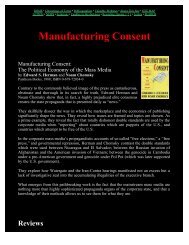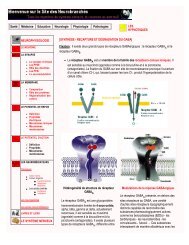The complexion of fear
The complexion of fear
The complexion of fear
You also want an ePaper? Increase the reach of your titles
YUMPU automatically turns print PDFs into web optimized ePapers that Google loves.
updated at midnight GMT today is wednesday, march 5search nature science update go advanced search<strong>The</strong> <strong>complexion</strong> <strong>of</strong> <strong>fear</strong>26 August 1999HENRY GEEAn anxious mouse could provide a useful tool for testingdrugs against stress disorders in humans. Because theresearchers know exactly why the mouse is anxious, rightdown to the molecular level, the path is now clear toalleviate a range <strong>of</strong> distressing disorders in people whomay be genetically predisposed to anxiety following sometraumatic experience.Anxiety disorders belong on the borders between geneticsand experience. Although people vary enormously in theirresponses to traumatic experiences such as combat, rapeor seeing a disturbing horror film, there are clear signs thatgenes are involved. For example, the shared incidence <strong>of</strong>post-traumatic stress disorder (PTSD) among combatveterans is higher in identical than in fraternal twins.But what are the genes involved? A clue comes from theaction <strong>of</strong> drugs commonly used to treat anxiety in theclinical setting. Valium, for example, works by binding to areceptor in the brain that normally responds to a chemicalcalled gamma-aminobutyric acid (GABA, for short). Fromthis, it seems clear that defective binding <strong>of</strong> GABA to itsreceptor might lie at the root <strong>of</strong> anxiety disorders. Giventhat the GABA receptor is made <strong>of</strong> proteins that areencoded by genes, it could be that the genes for the GABAreceptor are as prone to disabling mutations as any other.• Antibodies crippleprions6 March 2003• Ancient ape foundin orangutan'shomeland6 March 2003• Yeast evolutionreversed6 March 2003• Robot finger hasfeeling5 March 2003• Cells moved bygeometry5 March 2003This seems likely, given the results <strong>of</strong> work on a strain <strong>of</strong>mouse genetically engineered to have defective GABAreceptors, as reported in the September issue <strong>of</strong> NatureNeuroscience 1 by Florence Crestani <strong>of</strong> the Swiss FederalInstitute <strong>of</strong> Technology and the University <strong>of</strong> Zurich,Switzerland and colleagues. In maze tests used to assessbehaviour, mutant mice (that is, ones with defective GABAreceptors) avoided new and potentially threateningsituations, such as having to walk across narrow bridgeswithout sides. <strong>The</strong> mice also tended to overreact topotential threats, compared with normal mice. All in all, themice exhibited a range <strong>of</strong> behaviour seen in stressedhumans, such as the tendency to see threats in ambiguous,novel situations, regardless <strong>of</strong> the actual degree <strong>of</strong> threatposed. As if to underline the conclusions, the mutant miceresponded positively to small doses <strong>of</strong> Valium-like drugsthat had no effect on normal mice.With such a happy ending, it seems clear that we shouldhave nothing to <strong>fear</strong> except <strong>fear</strong> itself.
References1. Mohler, H. et al. Decreased GABAA-receptor clusteringresultsin enhanced anxiety and a bias for threat cues. NatureNeuroscience, 2, 833 - 839, (1999).© Nature News Service / Macmillan Magazines Ltd 2001






